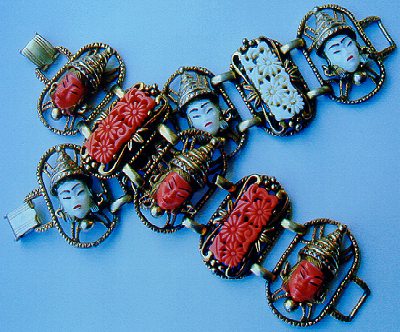
Selro & Selini Jewelry: Styles and Findings
August 24, 2019
Vintage Necklaces Styles
August 24, 2019Costume Jewelry Collectors Int’l
is pleased to host
RESEARCHING COSTUME JEWELRY
originally created and published by Dotty Stringfield on IllusionJewels.com
Written by Susan Klein
Printed with permission of Susan Klein and Antiques & Collecting Magazine
© 2009
Costume jewelry aficionados have long admired the mysterious faces of Selro jewelry, but little was known about the company itself or the man behind the manufacture of this incredible jewelry.

Paul Selenger
Paul Selenger was born in Odessa, Russia in 1911. In 1927, he immigrated to the United States with his mother Rose and sister Fannie. The family settled in Brooklyn, New York and by 1930 Selenger and his sister had jobs as salespeople in a novelty store. Selenger became a U.S. citizen in 1942 and served his new country as a Staff Sergeant in North Africa during World War II.
Early in his costume jewelry career, he worked for H. Pomerantz & Co. in New York. At some point in the late 1940s, Selenger opened his own firm, Selro, which was named for his mother Rose. His sister Fanny also helped him in the business. Selenger’s niece Marian Faytell says that her uncle had his own factory in New York City from the 1950s to the early 1960s. The factory was located in the area of the West 30s in Manhattan and Selenger employed a model maker and others who did ‘bench’ work. Faytell believes that later on he may have also had another manufacturing location in Providence, RI. Faytell remembers him traveling weekly to Providence.

Hattie Carnegie Pin
Designer and manufacturer Leo Geller remembers him as a great guy and a true artisan. Geller’s company Expansion Bracelet (Later Expansion Ltd.) manufactured some of Selro’s stock between 1960 and 1975. Geller also said that Selenger designed a line for Hattie Carnegie. Evidence that Paul Selenger designed a line of jewelry for Hattie Carnegie is an Asian woman face inset into an elaborate four leaf clover pin (shown here courtesy http:/www.deja-voodoo.com).
Often, figural jewelry from Selro is confused with that of the manufacturer HAR. Many wonder if there was a connection between the two companies. Faytell said that Selenger had hundreds of pieces of HAR in his personal collection. Geller, however, says there was no connection whatsoever between HAR and Selro. Geller also manufactured jewelry for HAR and remembers that the owner of HAR was an Englishman, but does not remember his name. (NOTE: Updated information on HAR came to light after the magazine this article originally appeared in went to press. See The Mystery of Har Jewelry for more information.)

Selro Jewelry
Selro merchandise was distributed through a New York wholesaler called Fran & Co., which placed jewelry from such manufacturers as, Art, JJ and American Chanel, in department stores such as Marshall Field’s, Wieboldt’s, and Goldblatt’s. The original Fran and Co. price tags denote the wholesale price to the individual department stores. Many in the costume jewelry industry remember Selenger as a “jobber”(or independent manufacturer’s representative) in the costume jewelry industry for a number of companies, including Florenza and Capri. In the 1970s, after he closed Selro, he served as this bridge between the factories and the wholesalers.

Selro Devil Bracelets
The Selro Company itself was always based in New York City. Selenger also manufactured jewelry under the name Selini and possibly, under the name Selan, but the main company was called Selro Corp. According to Faytell, the telephone at the company was answered “Selro”. For a time, Selro and Selini were produced simultaneously. Occasionally, jewelry can even be found featuring both the Selro and Selini marks. Selenger himself designed the unique Selro/Selini pieces.
For more information on this type of jewelry, read Selro & Selini Jewelry: Styles & Findings.
Researching Costume Jewelry — Home
Copyright 1997 to present — www.costumejewelrycollectors.com — All Rights Reserved.
All RCJ publications and pages were created
by Dotty Stringfield with the assistance of research contributor Pat Seal
and other valued members of the costume jewelry collecting community.


